La paura del parto: quali profili psicologici?
Titolo Rivista PSICOLOGIA DELLA SALUTE
Autori/Curatori Sara Molgora, Valentina Fenaroli, Emanuela Saita
Anno di pubblicazione 2018 Fascicolo 2018/1
Lingua Italiano Numero pagine 13 P. 103-115 Dimensione file 217 KB
DOI 10.3280/PDS2018-001006
Il DOI è il codice a barre della proprietà intellettuale: per saperne di più
clicca qui
Qui sotto puoi vedere in anteprima la prima pagina di questo articolo.
Se questo articolo ti interessa, lo puoi acquistare (e scaricare in formato pdf) seguendo le facili indicazioni per acquistare il download credit. Acquista Download Credits per scaricare questo Articolo in formato PDF

FrancoAngeli è membro della Publishers International Linking Association, Inc (PILA)associazione indipendente e non profit per facilitare (attraverso i servizi tecnologici implementati da CrossRef.org) l’accesso degli studiosi ai contenuti digitali nelle pubblicazioni professionali e scientifiche
La paura del parto rappresenta un sentimento sperimentato da circa il 20-25% delle future madri. Essa può essere distinta in base al suo grado di intensità: se una paura lieve o moderata esprime una preoccupazione adattiva, una paura intensa si configura come un disturbo vero e proprio, che interferisce con la vita quotidiana della donna e che può ostacolare la sua capacità di affrontare il travaglio ed il parto. Numerosi studi hanno indagato il costrutto di paura del parto, non raggiungendo, tuttavia, un consenso unanime sulla sua definizione, in particolare circa il legame con ansia e depressione. Il presente contributo intende esplorare l’esistenza di differenti "profili di donne", sulla base dell’intensità di paura del parto e della presenza di sintomi ansiosi e/o depressivi durante la gravidanza. 198 nullipare tra il 7° e l’8° mese di gravidanza hanno compilato i seguenti questionari: Wijma Delivery Expectancy Questionnaire, Edinburgh Postnatal Depression Scale e State-Trait Anxiety Inventory. I risultati indicano la presenza di tre differenti cluster: il primo (benessere) è composto da donne con punteggi medi inferiori ai valori soglia in tutte e tre le scale; il secondo (ansia gestazionale) raggruppa le gestanti con ansia di stato superiore al cut-off; al terzo cluster (sintomatologia ansioso-depressiva), infine, appartengono le future madri che presentano punteggi medi elevati in tutte le scale (valori clinici o sub-clinici). L’esistenza di distinti profili di gestanti porta ad ipotizzare che la paura del parto possa assumere significati specifici all’interno di ciascun pattern e che sia possibile individuare "paure" del parto.
Parole chiave:Paura del parto, ansia, depressione, cluster analysis, profili psicologici.
Sara Molgora, Valentina Fenaroli, Emanuela Saita, La paura del parto: quali profili psicologici? in "PSICOLOGIA DELLA SALUTE" 1/2018, pp 103-115, DOI: 10.3280/PDS2018-001006